🙂 🙂
 |

A khatta-meetha take on life around me through my presbiopic eyes!
None
of us rush to answer a ringing telephone anymore; as there is a hefty chance it
will be someone trying to sell an insurance policy/credit card/ loan. I
have yet to meet a person who has taken up this telephonic loan proposal. The
range of products being touted via SMSs range from ‘sizzling’ celebrity photo
and music downloads to meal deals, mock croc bags and several other frivolous
accessories!
Located in central India, Bhopal is the capital of Madhya Pradesh state and I had often transited this city during train journeys but had never actually stayed there. Sanchi is located to the north east of Bhopal at a distance of about 45 kms. It is home to the Buddhist monuments – the Stupas that show case Buddhist art and architecture. This is designated as Unesco World Heritage Site. It dates back to some time in the 3rd century BC and was constructed by Emperor Ashoka. After its hey day period, it was ignored and forgotten for several hundred years. It was re-discovered and then explored and developed by British Officers during the Raj. There are plenty of reviews and descriptions of this site available on the internet so I would not like to repeat those. This page on the website of the Archeological Survey of India offers excellent information.
 |
| Buddhist Monuments at Sanchi |
Sanchi is easily accessible by road from Bhopal. Entry is with a nominally priced ticket and the guard at the entrance politely told us not to eat inside. There is an excellent museum near the ticket hut but I suggest visiting it after seeing the Stupas. Its a very good idea to take services of a local guide as they have an uncanny knack of retelling the history of the place and bringing it alive.
The main stupa (Stupa 1) is said to hold the remains of Gautam Buddha and the other stupas are of his disciples. It is distinguished by its bigger size and by the triple umbrella (chhatravali) on its dome. It has four entrances (toranas) and the southern one is thought to have
been the principal entrance. The
other ones (east, west, north) were built later. Each gateway has two pillars (square with carvings on all sides) and a superstructure of curviform architraves (also carved with different stories).
Our guide brought attention to details inscribed on the pillars which relate the life and preachings of Gautam Buddha and Jataka tales. Parts of the site have been restored. At no site is the Buddha depicted in the form that we now know him to be but he is depicted symbolically. E.g. Umbrella held above the throne, dharma chakra, footprints etc.
If you happen to visit any place near Sanchi do make it a point to go there. It has a serene atmosphere and the Gautam Buddha’s ideas are conveyed in a very subtle manner via the carvings. There are beautiful seats under the trees that are ideal for this purpose. The skills of the artisans in years gone by is humbling especially considering that they did not have the so-called advantage of ‘modern’ technology. Dont miss the stone pillar with a mirror like polish or the huge stones that would have been hauled from miles away and then installed in its position or the interlocking cylindrical stones that form the peripheral boundary of the main Stupa. These are just a few examples. There are many more at Sanchi. .
This site has special walkways for visually challenged individuals and a sign post in braille. This is among the few places that I have seen that offers this facility for the differently-abled.
At the entrance is a small shop that sells some brochures and CDs that have extensive information and history of the site. However they do not have any significant mementos or fridge magnets (I am really partial to those!) which is sad considering that this is such an important destination. I do hope concerned authorities do something to rectify this. Rest rooms are available and there is small shop that sells basic food
items. So do go prepared with snacks or something to eat depending on
where you have travelled from.
Here is a slide show of some of some photos. It only gives a glimpse of the beautiful place and the images probably do not do full justice. Double click on the image for the slide show to open in a new tab… then its possible to read additional descriptions of the photos.
Considering my interest in trees, this blog will be incomplete if I don’t write about the trees I saw there. The most important is the Bodhi tree planted just at the entrance. There are several Khirni trees at Sanchi, all flourishing and their shiny dark green leaves glowed in the cool morning sun. I also noticed a Kalam (Mitragyna parviflora), lots of Bougainvilla and other trees usually used for landscaping. Here is a slideshow of the trees at the Buddhist monuments at Sanchi.
Enjoy!
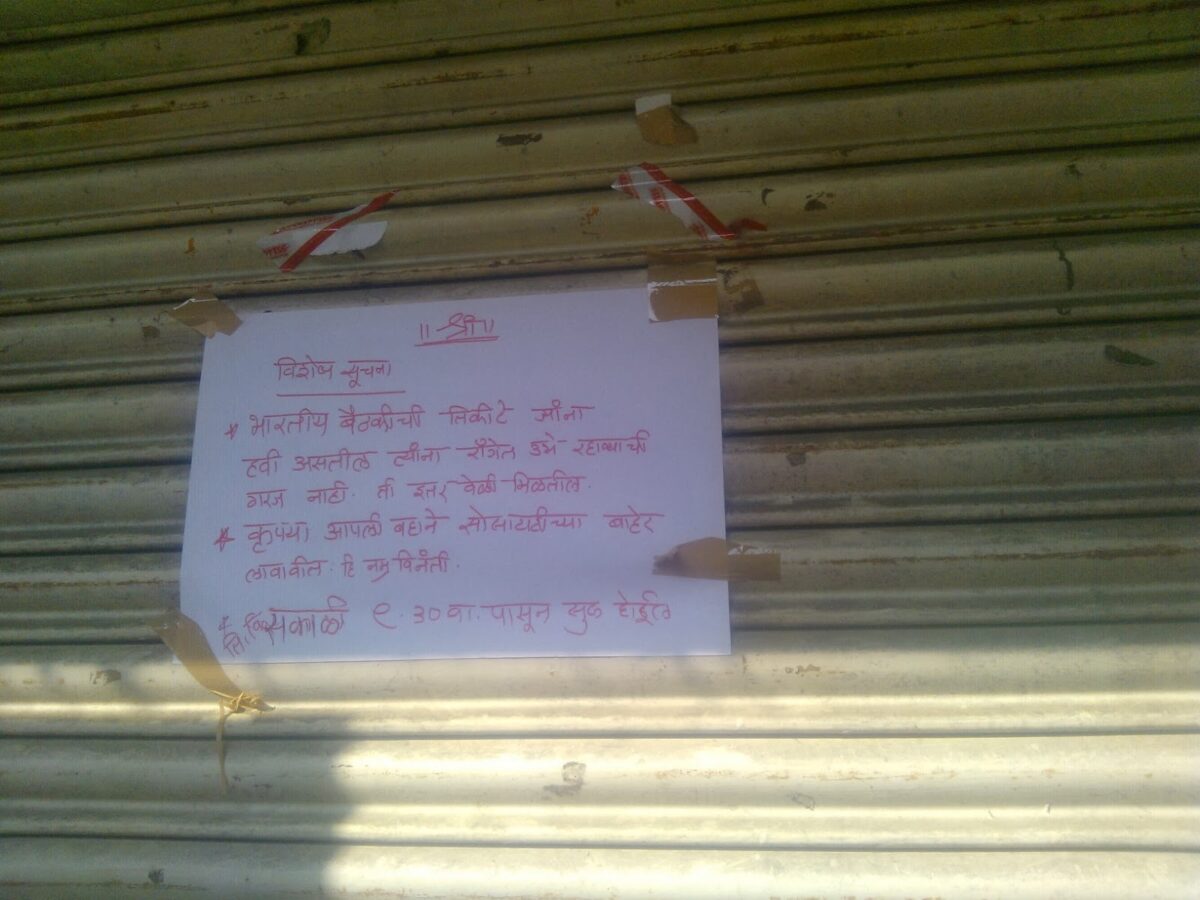
As Sunrise approached the line slowly
became longer. Unluckily the tapris located nearby that would have provided
much needed chai were demolished just the previous day by the Anti-encroachment
squad.

Here is the link to the Mahotsav website: http://sawaigandharvabhimsenmahotsav.com/
But in this day and age, why can there not be a more user friendly method to sell tickets? If it already exists, then music lovers should be informed about it.
Agree?
Hibiscus or Jaswanda as it is called in Marathi grows profusely in and around Pune but it blooms only for a day. The fully grown buds of Hibiscus bloom after sunrise and shut in the
evening. By the time night falls, the buds are fully closed. While one can buy many types of flowers the Hibiscus and Prajakta are two flowers that are rarely sold in the markets. This can be a challenge for the devout as the buds need not necessarily bloom on the day of their Pooja. This may not always happen. So one commonly sees people straining to pluck buds from trees growing along compound walls as they return from their morning walks!
A relative told me a method to ‘trick’ the buds to delay their blooming. This way one can collect mature buds and get them to flower later than the day they would normally. My experiment aimed for a one-day delay but maybe it will work for two days as well. I’ll try that the next time I have a bigger harvest of mature buds and let you all know!!
Here is what I did and I have a set of photographs to show you how the bud/flower behaved.

On a particular day (lets call it Day minus 1) my Hibiscus had about five mature buds that were set to open the next day (lets call it Day 1). I wanted to use the flower on the day after that (to be called Day 2). Under normal circumstances, the buds would have all bloomed on Day 1 and I would have had no blooming flowers on Day 2.
I plucked the buds and kept two of them in the fridge on the evening on Day minus 1.
On Day 1, I took them out and let them stand in some water. The buds were still tightly closed, the other buds of the same ‘age’ had bloomed fully. I used them in my Pooja.
 |
| 1. Hibiscus buds were tightly closed after being kept ovenight in the fridge |
The petals opened slowly and I monitored their progress through Day 1. The photographs have been taken in the afternoon, late evening and night.
 |
| 2. About one hour outside the fridge. |
 |
| 3. Afternoon of Day 1. Petals start opening |
 |
| 4. Evening of Day 1: Partially open buds |
At end of Day 1, the other flowers had closed and these remained in the partially open state.
The buds stayed in water overnight in the room.
 |
| 5. Night Day 1. Partially opened flowers. (9.29PM) |
Day 2: The buds bloomed fully and stayed open for the entire day. The petals shut tightly as the end ended.
 |
| 6. Fully open flowers (5.40AM) |
 |
| 7. The flower of the previous day (Day 1) had closed. These flowers stayed fresh and fully open. (9.29AM) |
 |
| 8. Petals close in the evening. (6.09PM) |
This seems to suggest that the flowers can be ‘tricked’ into blooming later. Their overnight stay in the dark refrigerator must have worked.
While writing this post, I came across this article that offers tips to keep Hibiscus flowers open.
I do not know if we can keep the buds in the fridge for another day
so that they can bloom on Day 3. If any of you tries this, do let us
know.
Take care!
Update (07 Oct 2013): Recently I have seen Hibiscus flowers for sale but this is very very rare. In the meantime you can try my experiment…
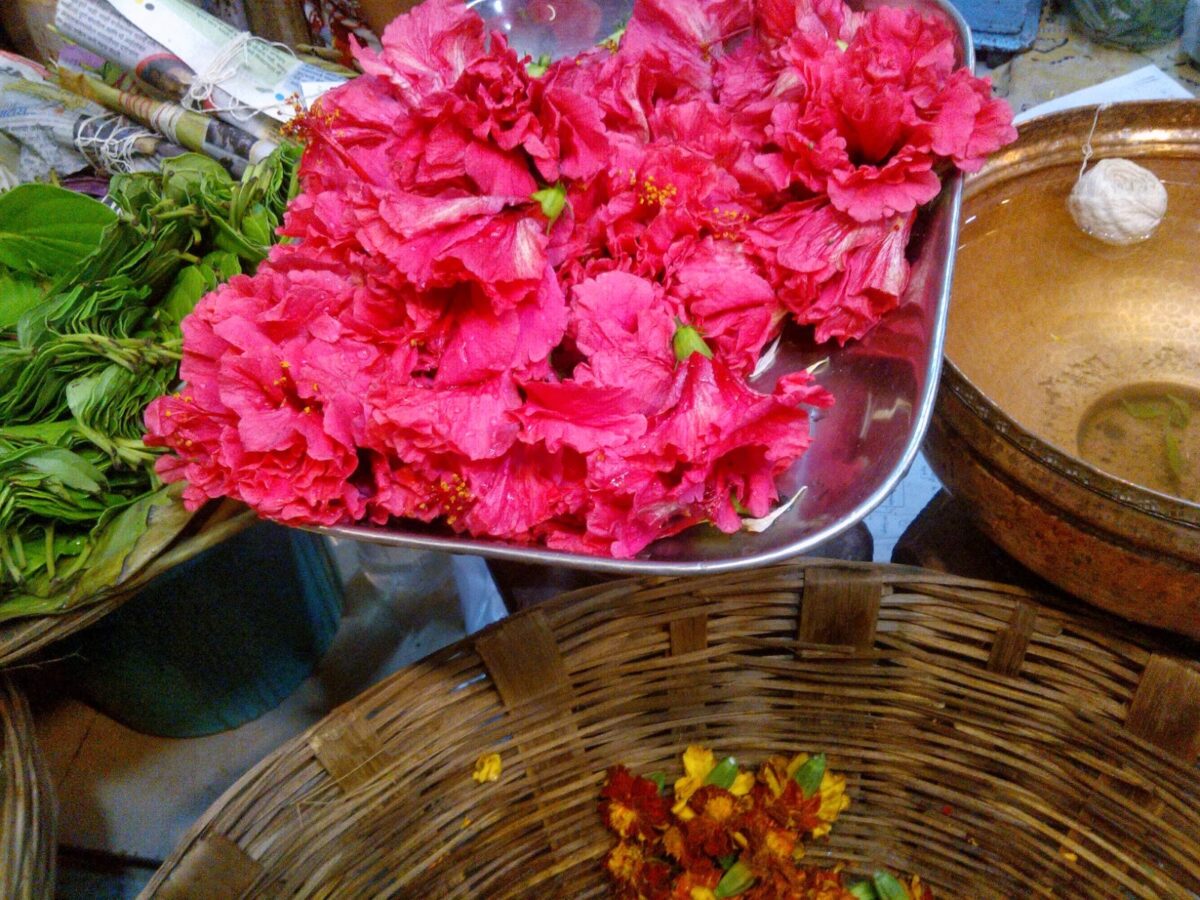 |
| Hibiscus flowers are not always sold in the market. |
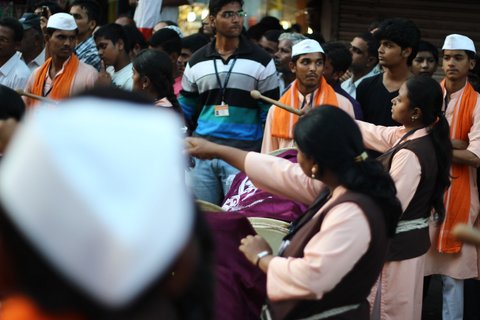
Yes, these Dhol pathaks are always in the news for the ‘noise pollution’ they create and less for the tradition they represent. The dailies devote almost equal space to articles and photos that ‘glorify’ these pathaks and articles that describe how ‘bad’ the dhol beats are for our ears, for the participants’ ears and indeed for our entire body. According to this article, a typical 28-inch dhol generates sound in the 3-4Hz and tasha in the 3-22Hz range (peaking at 11Hz). This Times of India article (published on 11 Sep 2013 in Pune) quotes audiologist Kalyani Mandke as saying “Long term exposure to these vibrations can affect a person’s circulatory and/or urological systems. The person playing the instrument is at highest risk, but people in its vicinity cannot escape its effects either.” Read it for more details about a study that describes ill effects of vibrations and frequencies on the human body.
Being a health professional, I understand the gravity of the situation. Just under an hour at a dhol practise venue left my ear drums in a protective ‘shut down’ for two hours. Some of the beats actually cause a wierd feeling in the chest (probably due to the vibrations mentioned in the above article).
Does that mean the ‘Dhol tasha’ are to be eliminated all together? Do we let this tradition die?
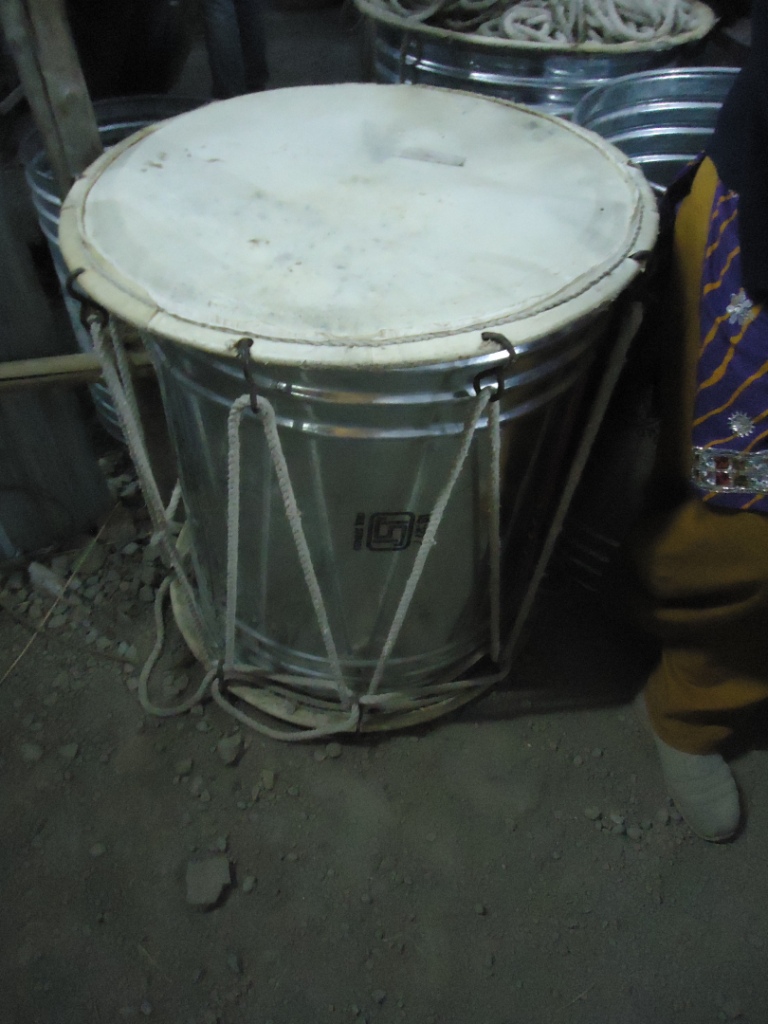 |
| Dhol |
On another note, I would like to know if DJ’s also face similar health hazards? Or technicians who work near aircraft on runways? I have seen them use ear defenders at civilian airports and at military bases where we were posted. And what about people who work with heavy-duty drilling equipment?
Drums Circle is a new trend that is used for team building and stress relief and it has immense therapeutic value as well in differently abled children. Obviously the sound levels there must not be as high as created by the dhols.

Is it possible to use some kind of ear defenders that will afford some amount of protection and allow the dhol to be played in a safer manner? Instead of criticising and rejecting the dhol tasha, should we not try to find a golden mean? Ideas anyone??
Think rationally.
Preserve our heritage and culture and stay healthy!
Cheers!
This year I had an opportunity to visit one group during their practise sessions. As I mentioned earlier, training begins at least a month before Ganesh Utsav. People from all walks of life get together each evening for about four hours of practise. The Raja Mantri Path in Pune has several groups practising simultaneously which can be troublesome for people living close by. I spent just under an hour there and my ear drums went into a defensive shutdown that lasted for over two hours thereafter! The groups seemed to be well organised and disciplined. The air reverberated with different beats that grew louder as we approached the practise area.
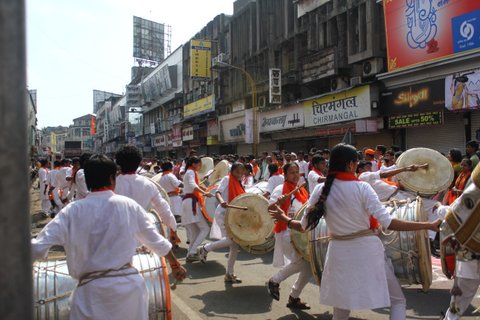 |
| A Dhol pathak during the 2012 Ganesh visarjan procession, this image taken on Laxmi Road. |
Practise was on full swing and they did not stop for even a minute for the period we stood there. They obviously forcefully struck the stick on the dhol but the beats seemed to invigorate them rather than tire. The group seemed to follow an apparently invisible command set by the leader (invisible to outsiders) as they smoothly changed their strokes. That’s great team effort!
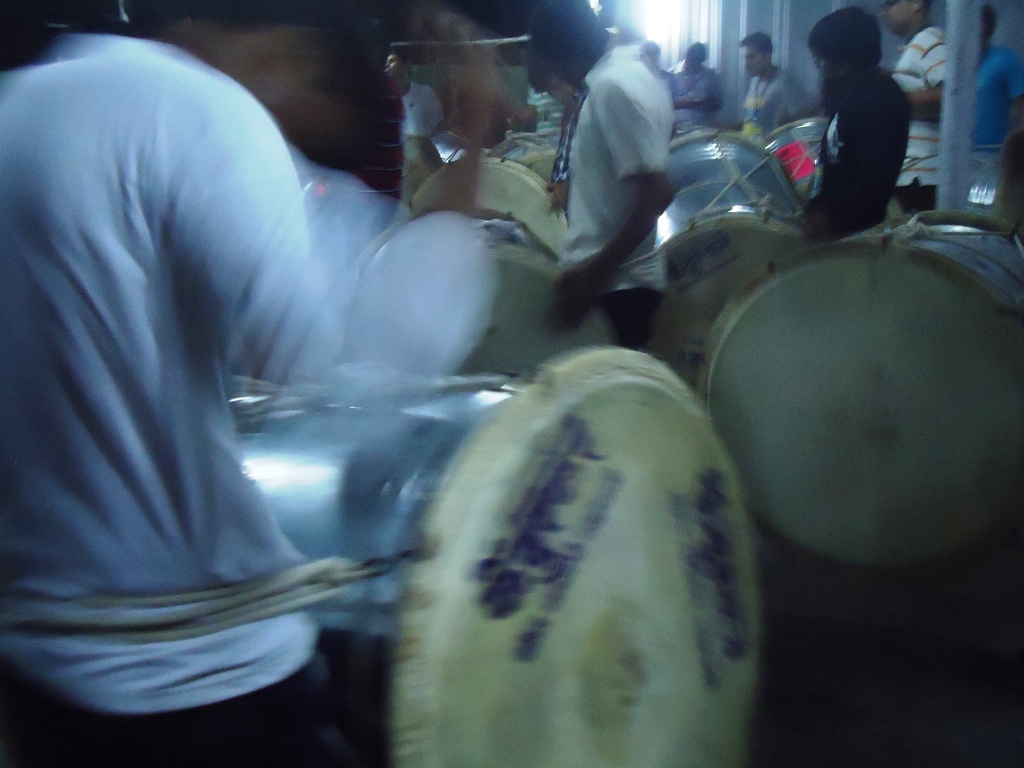 |
| I wonder if this image conveys the speed and force with which the dhol players strike the drums… |
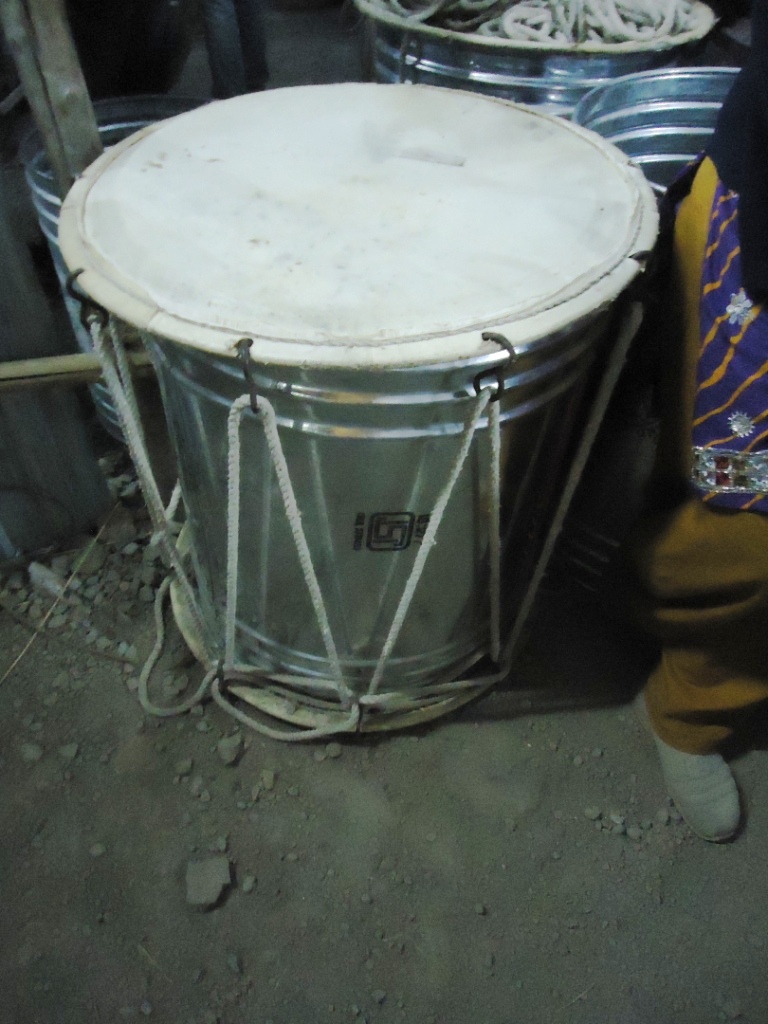 |
| Dhol |
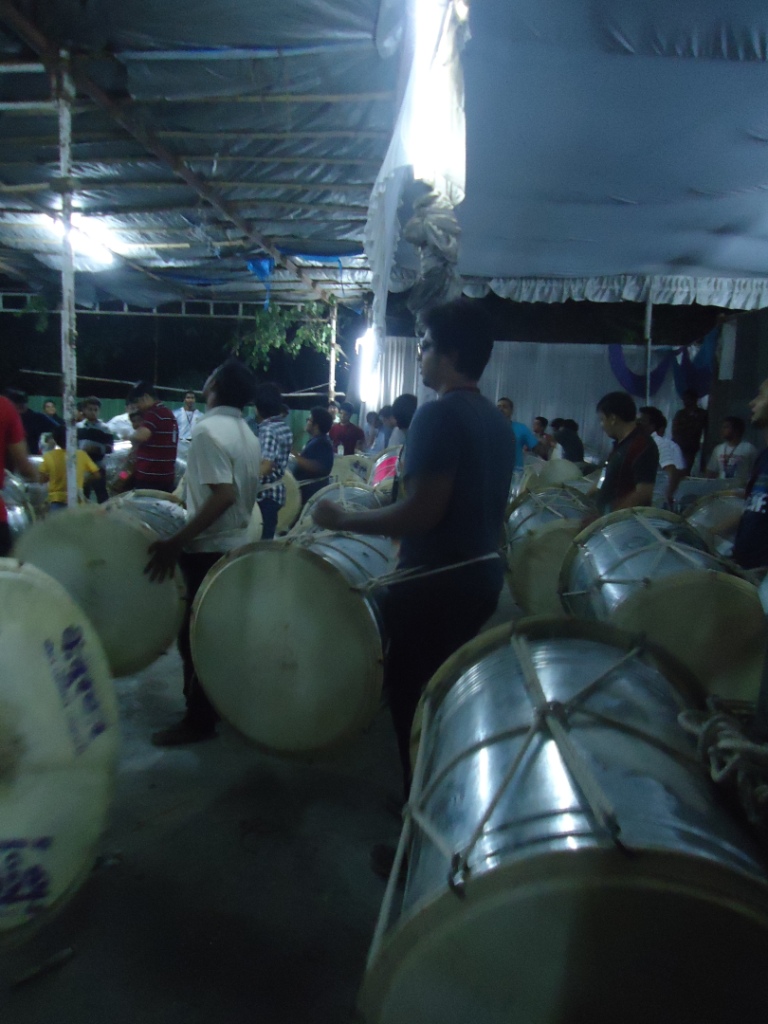 |
| The group practises |
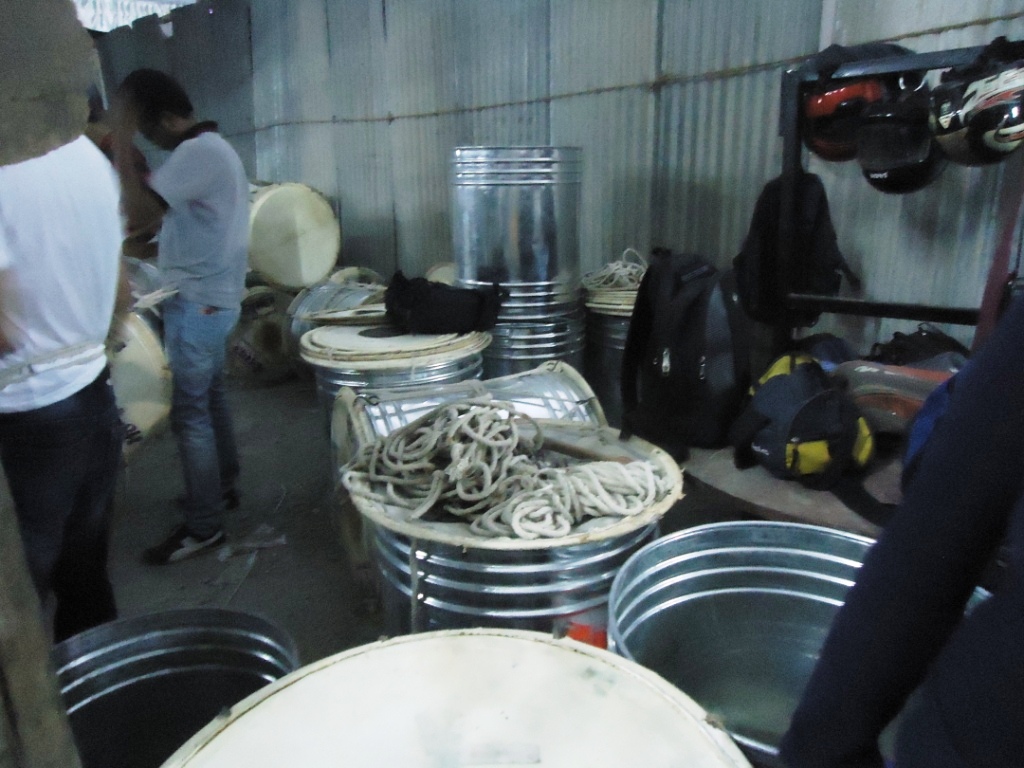 |
| Participants come straight from work, college to practise |
I tried carrying the instrument and it seemed to weigh about 5 kgs, which is not much considering its size. It is carried strapped around the waist and a stick called “Tippru” is used to strike one side of the dhol. The other side is struck with the palm of the hand. Girls/women use a slighlty smaller dhol but there is not much of a difference I am told. Smaller drums called ‘tasha’ are also part of the troupe along with big dhols. The entire group plays together to create memerising catchy unforgettable rhythms. An average pathak can have 40-60 people.
Vidyesh has come to Pune all the way from Nagpur just to participate. He has had an amazing experience so far and given a chance would like to come again next year! He says, “Yes the practise is tiring but when we play at full power and full rhythm the pleasure acts as a pain killer!” They use cotton balls to protect their ears he said but after a while they get used to the sound.
Its people like Vidyesh and the many others like him who manage to juggle time with their jobs who are helping keep this traditional art form alive and flourishing. This Ganeshutsav, do go out and enjoy the processions especially the foot tapping,decibel defying dhol!
Cheers!
Ask anyone who has stayed awake at night when her baby was crying or bit off her nails when the ‘apple of her eye’ was in a school interview or tied herself in knots when her kid’s school bus was unreasonably delayed or has had high decibel, lachrymose arguments as the children grow up for not seeing eye to eye about the colour of the nail polish or site or type of the strange tattoo …
Yet when that ‘next’ phase arrives she finds that the maternal stress never ended nor for the phase thereafter…
There is much written about Motherhood and all it stands for. Selfless Love, Sacrifice, Teaching (customs, traditions, manners, family religious rites and so on…) to name just a few things a Mum is expected to do and do well. Naturally this ‘mothering’ takes a toll in the form of worrying and becomes a second nature to her, especially whenever her child is in front of her.
This is the crux- the child (son or daughter) always remains a child in her eyes. Whether the baby is now school going or a college or post grad student or when about to get married and to top it all… when her ‘child’ has one of his own…
So now she is worrying for her child and the child’s child. There are many Marathi Moms who baby sit their grandchildren as their own children are working. So the grandmother manages (ignores) any of her own age related ailments and plunges into nurturing the young ones… This process continues for the next generation as well, trust me… I have experienced it!!
Here I have to admit that I know a few Moms who have not gone down this “babysit the grandchild” Street but that doesn’t mean they don’t worry.
I think Moms must learn to mentally stay aloof so that they can give sensible and practical advice – IF its sought- to their children (now adults) about their children. Sounds complicated? No one said Motherhood is easy… This strategic mental aloofness is vital so she continues to have time for her own hobbies/activities/friends, devote time for exercise/health and so on…
All this sounds easy to write, or agree to but when put in the actual situation, I am not sure…
Honestly, Does a Mom ever retire? Can she?